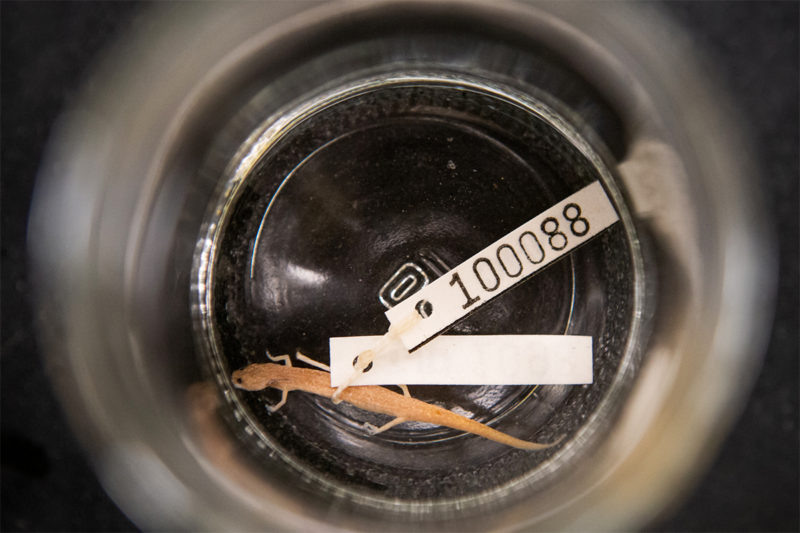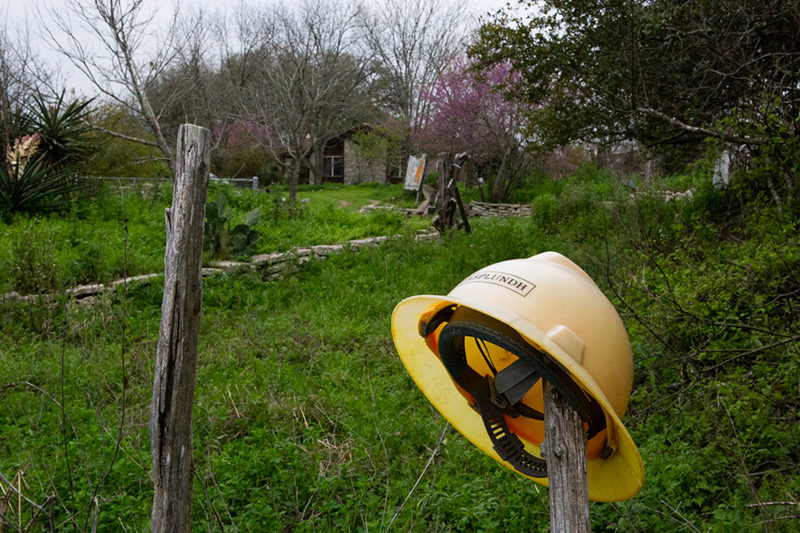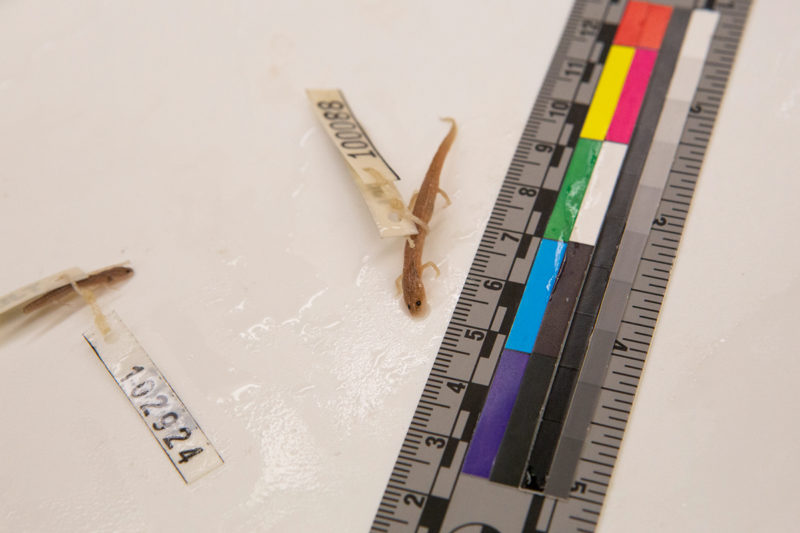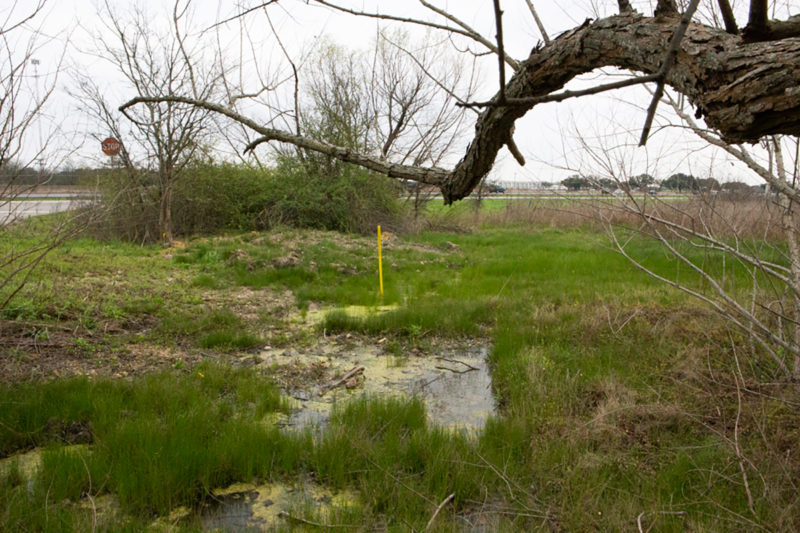Kinder Morgan, the Blind Eyes of Texas Salamanders Are Upon You
By Kayla Meyertons
Reporting Texas

A salamander specimen is seen in a jar at the J.J. Pickle Research Campus on Feb. 22, 2019. Isaiah Zaragoza/Reporting Texas
Opponents of a proposed $2 billion natural gas pipeline through the Texas Hill Country worry about the potential for damage to fragile aquifers during construction or, once it’s operating, contamination from leaks.
The proposed 42-inch steel pipeline, to be built by the energy infrastructure company Kinder Morgan, would stretch 430 miles from West Texas to Houston. It would cut as deep as 9 feet into the ground over certain areas of the Edwards and Hays Trinity aquifers and the sinkholes and caves that allow surface water to trickle down into the aquifers.
“Given the nature of surface and groundwater relationships, especially in northern Hays County, it’s extremely risky,” said Andy Gluesenkamp, a biologist and director of conservation at the San Antonio Zoo.
An environmental impact study examining the risks would ease Gluesenkamp’s concerns, but because the pipeline would be located entirely within Texas, Kinder Morgan is not required to do one.
Thanks to some endangered salamanders that call these ecosystems home, Gluesenkamp may get a reasonable facsimile of the study. Under the Endangered Species Act, Kinder Morgan must provide a biological assessment of species threat levels to U.S. Fish & Wildlife Service, which then provides its biological opinion of the proposal. To get approval for the pipeline, Kinder Morgan must show it will minimize damage to species habitat and mitigate any damage it cannot avoid.
“You can’t design a project that is going to exceed the regulatory requirements, not just for salamanders but for all endangered species,” said Allen Fore, vice president of public affairs for Kinder Morgan.
Kinder Morgan operates about 26,000 miles of natural gas, CO2, crude and refined products pipelines and 15 terminals in Texas, Fore said. The Kinder Morgan Texas Pipeline, a 2,100-mile intrastate natural gas pipeline, has been operating through Blanco County for 60 years.
The proposed pipeline would capture the large amounts of natural gas being flared, or extracted and burned off, in the Permian Basin, Fore said. Pure natural gas is mostly methane, an odorless greenhouse gas that, when released directly into the air, contributes to global warming.
Fore said environmental specialists will survey the land along a 600-foot corridor even though Kinder Morgan needs only 50 feet to install the pipeline. To sample below ground, the company will use ground-penetrating radar and boring technology, he said.
Gluesenkamp said that along the proposed route, aquifer depths range from surface outcroppings to hundreds of feet deep and that groundwater salamanders can inhabit springs, spring runs, spring-fed creeks, caves, aquifers and underground streams or pools deep in limestone rock. He argued that trenching and drilling bores can directly impact subsurface salamander habitats and groundwater flow routes.

A construction hat sits on a post on Opal Lane in Kyle, Texas, on March 3, 2019, near where the future Kinder Morgan pipeline is set to be constructed. Isaiah Zaragoza/Reporting Texas
“[Boring] through underlying limestone to install a pipeline can … disrupt those existing recharge patterns or stop flow entirely,” Gluesenkamp said. “It raises the possibility if there’s a leak into the aquifer of these extremely toxic substances, that will destroy all these organisms very quickly.”
Salamanders depend on a constant supply of cool, clean aquifer water to survive, according to the Texas Parks & Wildlife Department website. Threatened or endangered salamanders in aquifers along the pipeline route include the San Marcos, Comal blind, Barton Springs, Austin blind, Blanco blind and Texas blind.
Gluesenkamp said the aquifers also are home to other federally endangered species, including the San Marcos gambushia, fountain darters, Comal Springs riffle beetles and dryopid beetles.
Lesli Gray, a public affairs specialist for Fish & Wildlife, said the department will work with Kinder Morgan to identify risks to the protected species and devise ways to protect them. Part of the job is to anticipate any incidental takes, or consequences of the project that are not purposeful or direct, Gray said.
Fish & Wildlife is awaiting complete information on alignment, construction methods and trenching depths before entering any formal consultation process with the company, she said.
Gluesenkamp said he is encouraged by Fish & Wildlife’s role given the agency’s access to resources.
It “definitely provides a backstop for oversight on where and how they build this pipeline,” Gluesenkamp said. “I’m happy to hear that’s the situation. Kinder Morgan is not required to tell us that, but I think it would make people feel a lot more comfortable if they knew that U.S. Fish & Wildlife was involved.”

Two salamander specimens are seen at the J.J. Pickle Research Campus on Feb. 22, 2019. Isaiah Zaragoza/Reporting Texas
The Wimberley Valley Watershed Association, a nonprofit environmental group, is circulating a petition to reroute the pipeline out of the Hill Country and away from aquifers and waterways. The petition has received about 3,900 signatures as of early April with a goal of 10,000.
The Hill Country is simply not the place for a pipeline, said Ashley Waymouth, managing director of the association.
“In the event of a leak or an explosion or whatever the case may be in the future, we’ll all be affected,” Waymouth said. “The more people that we can get to sign this, then the more people that we can get to stand in solidarity against Kinder Morgan devastating our ecosystems [and] devastating our aquifers.”
The federal Pipeline and Hazardous Materials Safety Administration keeps records of pipeline incidents in the United States, and from 1999 to 2018, there were 11,991 incidents, 318 deaths and 1,305 injuries across the nation. Over this 20-year period, Texas alone had 2,952 pipeline incidents, 37 deaths and 145 injuries.
According to the records, hazardous liquids like crude oil make up most pipeline incidents, but gas distribution lines, pipelines that bring gas to consumers, caused more than half of the cumulative damage in injuries, deaths and explosions.
Alicia Reinmund-Martinez, general manager of the Barton Springs Edwards Aquifer Conservation District, said she worries Kinder Morgan will convert the pipeline to crude oil or another liquid petroleum product in the future. A leak that allowed crude oil to enter a karst feature, an opening where groundwater conduits form in dissolved
rock, could drastically impact aquifer species, especially salamanders.
Dye tracing tests have shown that during drought conditions, shallow water levels in the Trinity aquifer have been seen to pass water into San Marcos Springs and Barton Springs, Reinmund-Martinez said. The conservation district wants to make sure “there’s no liquid product making its way into a karst feature that could end up in the springs … and they have an expert if they do the construction.”
The conservation district board is investigating the potential impact of the pipeline before making a decision in support of any rerouting petition, Reinmund-Martinez said.

A field on the side of Opal Lane in Kyle, Texas, on March 3, 2019. Isaiah Zaragoza/Reporting Texas
Fore said Kinder Morgan has hired a karst expert to oversee the pipeline and prepare a mitigation plan in the event the pipeline hits a void space in the aquifer. The project also has a long-term contract for natural gas, he said. Converting to crude oil would require retrofitting the pipeline, building pump stations and going through an entirely new regulatory process.
Pipelines make up less than a hundredth of 1 percent of all transportation accidents in the United States and are the safest and most efficient way to transport natural gas, according to the National Transportation Safety Board. There are about 300,000 miles of natural gas transmission pipelines in the United States and more than 328,100 total intrastate pipeline miles in Texas.
“Leaks are extremely rare, and incidents on pipelines are extremely rare,” Fore said. “It’s like getting hit by lightning twice. That’s the rarity.”
The project will have a 24/7 monitoring system to shut down the pipeline remotely and valves that close automatically in the event of a leak, Fore says. A protection system also pulls corrosive agents away from the pipeline.
In February 2017, a Kinder Morgan natural gas pipeline exploded in Refugio, creating a massive fire. Kinder Morgan’s El Paso natural gas pipeline exploded Aug. 1, 2018, killing one and injuring at least five others.
“Why would it be in Kinder Morgan’s interest to build a pipeline that wasn’t compatible and was going to have problems? That would be pretty stupid,” Fore said. “We wouldn’t be proposing it unless we were confident from detailed engineering studies and detailed environmental studies that we can do this.”
If approved, construction of the pipeline is set to begin in fall 2019.